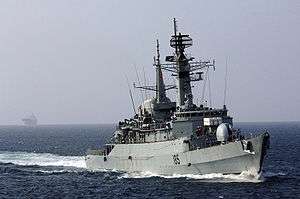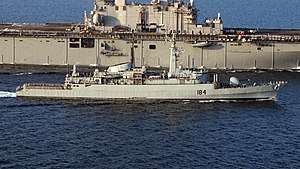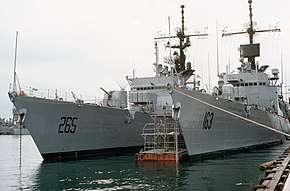Tariq-class destroyer
The Tariq-class destroyer are the class of guided missile destroyer warships that were acquired through transfer from the Royal Navy in 1993–94. The Tariqs were formerly commissioned in the Royal Navy's Surface Fleet as the Amazon class/Type 21 as they were only classified as a general purpose frigate in the Royal Navy.[5]
_operates_in_the_Persian_Gulf_as_part_of_the_Coalition_Maritime_Campaign_Plan_conducted_under_Commander_Task_Force_One_Five_Zero_(CTF-150).jpg) PNS Babur, a Tariq-class destroyer, in 2004 | |
| Class overview | |
|---|---|
| Name: | Tariq class |
| Builders: |
|
| Operators: |
|
| Preceded by: | Type 12 Leander |
| Succeeded by: | F-22P Zulfiquar |
| Cost: | $120 million USD (2002):97–98[1] |
| Built: | 1969–1975 |
| In commission: | 1993–present |
| Completed: | 6 |
| Active: | 3 |
| Retired: | 3[2] |
| General characteristics | |
| Type: | Destroyer/Guided missile[3][4] |
| Displacement: |
|
| Length: | 384 ft (117 m) o/a |
| Beam: | 41 ft 7 in (12.67 m) |
| Draft: | 19 ft 6 in (5.94 m) |
| Propulsion: |
|
| Speed: | 32 knots (59 km/h; 37 mph) |
| Range: | |
| Troops: | 2 × Btn, Pakistan Marines |
| Complement: | 15 Officers, 200 Enlists |
| Sensors and processing systems: |
|
| Electronic warfare & decoys: | TKWA/MASS (Multi Ammunition Softkill System) |
| Armament: |
|
| Aircraft carried: |
|
| Aviation facilities: | Flight deck and hangar |
The British frigates were immediately acquired when the United States refused to renew the lease of the four Garcia and four Brooke-class frigates, due to the enforcement of the Pressler Amendment.:147–148[6] Therefore, Pakistan had to return the vessels to the United States at the end of their five-year lease.:476[7]
Upon acquisition, all six frigates were reconfigured to enhance their engineering design and construction and military software updates that feature the Swedish technology, giving them missile launching capability.[8]
In 2008, the Pakistan Navy had carried out a successful test of the Camcopter S-100, an unmanned aerial vehicle, from the flight deck of a Tariq-class destroyer.[9] The Tariq-class destroyers are currently in process of phasing out from their services, and will eventually decommissioned by 2020.[10]
Ships
| Image | Name | Former name | Commissioned with RN | Fate |
|---|---|---|---|---|
_operates_in_the_Persian_Gulf_as_part_of_the_Coalition_Maritime_Campaign_Plan_conducted_under_Commander_Task_Force_One_Five_Zero_(CTF-150).jpg) | Babur | Amazon | Commissioned in the Royal Navy in 1974 | Transferred in 1993 to Pakistan Navy. Decommissioned in 2015. |
| Tariq | Ambuscade | Commissioned into Royal Navy in 1975. | Transferred to Pakistan Navy in 1993, currently in active duty service as the lead ship of her class. | |
 | Tippu Sultan | Avenger | Commissioned into Royal Navy in 1975 | Transferred to Pakistan Navy in 1994. Decommisioned. |
| Khaibar | Arrow | Commissioned into Royal Navy in 1976 | Transferred to Pakistan Navy in 1994, currently in active duty service. | |
 | Badr | Alacrity | Commissioned into Royal Navy in 1977 | Transferred to Pakistan Navy in 1994. Decommissioned in 2014.[2] |
_Shahjahan.jpeg) | Shah Jahan | Active | Commissioned into Royal Navy in 1977 | Transferred in 1994 to Pakistan Navy, currently in active duty service. |
Negotiation and procurement

Procurement and negotiation of acquiring the Type 21 frigates dates back to 1966 when the United Kingdom first offered to Pakistan to jointly built three Type 21 frigates but the Ayub administration rejected the proposal who wanted to allocate the funds to acquire Daphné-class submarines from France.:63[6] Since 1966, Pakistan Navy had long eyed of acquiring the Type-21 frigates from the United Kingdom, submitting several proposals to the Government of Pakistan to materialize the plans of acquiring the Type-21 frigates in 1970s.:65[6]
In 1987–88, Admiral T. K. Khan entered in negotiating with the Royal Navy and began lobbying to the Zia administration for releasing the funds to acquire the Type 21 frigates in 1988.:62–63[12]
Despite the initial efforts with the Royal Navy, the Pakistan Navy went towards leasing the four Garcia and four Brooke-class warships from the United States Navy in 1988, selected based on the technological evaluation and Pakistani military specifications.:147–148[6]:97[1] The lease was set for five years with an option of renewing or purchasing the lease afterwards based on the mutual understanding between two nations.:148[6]
After the enforcement of the military embargo by the United States Congress in 1994, the lease was not renewed, therefore, the eight warships had to be returned to the United States Navy in Singapore, resulting Pakistan's sea borders vulnerable to foreign activities.:148[6]:476[7]
During this time, Admiral S.M. Khan used his personal relations with the British Admiral of the Fleet Sir Julian Oswald, who helped him with negotiation with the British government to immediately procured and acquired the entire frigates of the Amazon class/Type 21 from the British Royal Navy in 1993–94.:476[7]
The Pakistan MoD authorized the purchase of the entire fleet of Type 21 frigates from the United Kingdom at a cheapest price tag of US$60 million, and reportedly spent nearly the same amount on classifying and modernizing the warships from their role as the general purpose frigates to destroyer standards.:97–98[1]
On 1 November 1993, the lead ship, Tariq (formerly HMS Ambuscade), reported to its base in Karachi and the transfer all warships completed on 1 January 1995.[8] The induction of the Tariq-class destroyers marked the replacement of the Garcia and Brooke-class frigates in the Pakistan Navy's surface command.[8]
Modernization
In 2002, it was reported that Pakistan had spent additional US$60 million to modernize the Tariq-class fleet according their Navy's specification from the general purpose frigates to the combat variant destroyer standards.:97–98[1] In the service of the Royal Navy, the Seacat, Exocet, torpedo tubes, and Lynx helicopters were distinct features in the Amazon/Type 21 frigates. With the Pakistan Navy's service, Exocet and the Seacat missiles were removed as well as torpedo tubes which were subsequently removed in all warships with the exception made in Badr and Shah Jahan.[8]
The weapon systems and computers fitted in the Tariqs features Swedish technology.[8] The flight deck and the Lynx helicopters remained with the Tariqs and arrived in Karachi with their respective warships.[8]
The Royal Navy did not transfer the Exocet and Seacat missiles that were replaced with the Chinese-made LY-60 SAM system.[8] Instead, the more capable U.S.-built Harpoon missiles were installed to replace the British weapon systems.[8] Extensive installation of computer software and missile deployments allowed the classification of Tariq from the DDE (destroyer escort) to the DDG (guided missile), with lead ship featuring the mixed installation of Zarb, Harpoon, and LY-60 guided missiles.[8]
In 2008, it was reported by the ISPR that the Pakistan Navy have successfully tested a flight takeoff and landing of the Camcopter S-100 UAV from a Tariq-class flight deck.[13]
References
- Cheema, Pervaiz Iqbal (2002). "Evolution of the Navy". The Armed Forces of Pakistan (google books) (1st ed.). NYU Press. p. 200. ISBN 9780814716335. Retrieved 17 September 2018.
- Ansari, Usman (19 May 2014). "Reports: Increase in Pakistan Defense and Nuclear Budgets Likely". Defense News. Retrieved 20 May 2014.
- "Amazon class Type 21 Frigate - Royal Navy". www.seaforces.org.
- "PNS Tariq (F181) Guided-Missile Destroyer Warship - Pakistan". Retrieved 24 November 2018.
- Goldrick, RAN, R. Adm James (1997). "Pakistan Navy: 1947–71". No Easy Answers: The Development of the Navies of India, Pakistan, Bangladesh, and Sri Lanka, 1945-1996 (PDF) (1st ed.). Surrey, Eng.: Lancer Publishers. p. 269. ISBN 9781897829028. Retrieved 15 September 2018.
- Shah, Mian Zahir (2001). Bubbles of Water: Or, Anecdotes of the Pakistan Navy. Karachi, Pakistan: PN Book Club Publication. p. 487. ISBN 9789698318031. Retrieved 25 January 2017.
- Shabbir, Usman (1 June 2003). "Tariq (Amazon) Class (TYPE 21) (DD/FF) « PakDef Military Consortium". pakdef.org. Karachi, Sindh Pak.: Pakistan Military Consortium. Retrieved 17 September 2018.
- Camcopter S-100 – Continued Success In Shipboard Trials (PDF), Schiebel Elektronische Geraete GmbH, 14 April 2008
- Anis, Ema; Ghauri, Irfan (21 April 2014). "Journalists' visit: Navy to shift focus to Ormara base" (html). The Express Tribune. Ormara, Balochistan, Pk.: The Express Tribune. The Express Tribune. Retrieved 14 December 2018.
(The Navy is in the gradual process of phasing out its old fleet of Type-21 warships-6, which were first inducted in the 1990s. Purchased from the British Royal Navy, one of these ships, PNS Badr, has already been decommissioned while the rest will be gradually phased out by 2020, informed by Commodore Faisal Abbasi.)
- Anwar, Muhammad (2006). Stolen Stripes and Broken Medals: Autobiography of a Senior Naval Officer (1st ed.). London, UK: AuthorHouse. p. 275. ISBN 9781425900205. Retrieved 15 September 2018.
- Camcopter S-100 – Continued Success In Shipboard Trials (PDF), Schiebel Elektronische Geraete GmbH, 14 April 2008